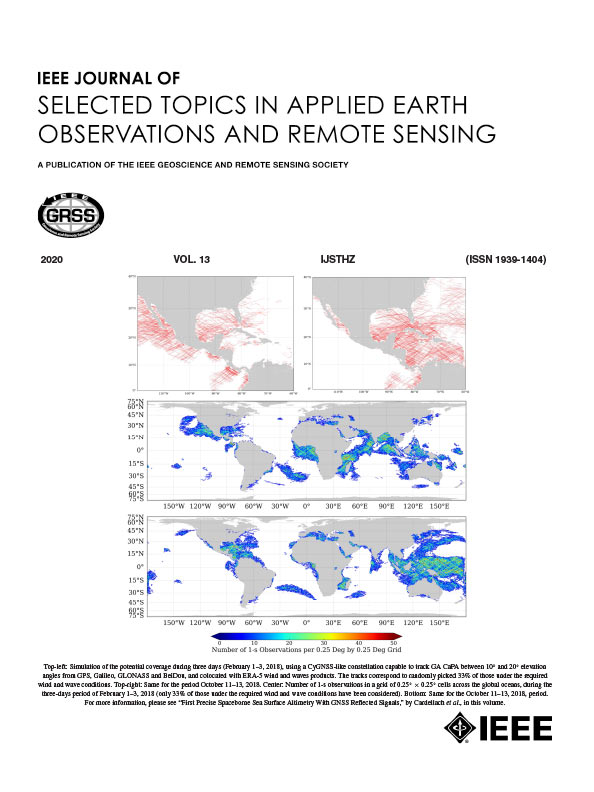基于长时间观测的运动舰船多姿态ISAR成像方法
IF 5.3
2区 地球科学
Q1 ENGINEERING, ELECTRICAL & ELECTRONIC
IEEE Journal of Selected Topics in Applied Earth Observations and Remote Sensing
Pub Date : 2025-08-22
DOI:10.1109/JSTARS.2025.3601604
引用次数: 0
摘要
长时间的合成孔径雷达观测有利于对运动目标的跟踪和识别。然而,在长时间观测中,运动目标姿态的持续变化会导致方位角信号的时频(TF)轨迹发生弯曲。TF轨迹的曲率导致图像散焦。由于姿态变化导致各散射体的轨迹曲率不同,传统的逆合成孔径雷达(ISAR)自动调焦方法无法获得理想的调焦效果。为了解决这一问题,我们提出了一种基于TF轨迹提取和补偿的ISAR成像方法。该方法将观测数据分成若干子时间间隔进行成像,从而可以捕获目标的各种运动姿态。该方法通过将变曲率TF轨迹转换为水平轨迹,有效地处理了非平稳区间,实现了非平稳区间的姿态图像采集。实验结果表明,该算法可以在长时间观测过程中生成多个船舶姿态图像,即使在复杂的运动场景下也能提供更清晰的图像。本文章由计算机程序翻译,如有差异,请以英文原文为准。
Long-Time Observation-Based Multiattitude ISAR Imaging Method for Moving Ships
Long-time synthetic aperture radar observation facilitates the tracking and identification of moving targets. However, continuous changes in the attitude of a moving target during long-duration observations cause the azimuth signal’s time–frequency (TF) trajectory to curve. The curvature of the TF trajectory leads to image defocusing. The varying degrees of trajectory curvature for each scatterer caused by attitude changes prevent the traditional inverse synthetic aperture radar (ISAR) autofocusing method from achieving ideal focusing results. To address this issue, we propose an innovative ISAR imaging method based on TF trajectory extraction and compensation. This method divides the observation into subtime intervals for imaging, allowing the capture of various motion attitudes of the target. By transforming the TF trajectories with varying curvature into horizontal trajectories, the proposed method effectively handles nonstationary intervals, enabling attitude image acquisition during these periods. Experimental results demonstrate that our algorithm can produce multiple attitude images of ships during long-time observations, delivering clearer imagery even in complex motion scenarios.
求助全文
通过发布文献求助,成功后即可免费获取论文全文。
去求助
来源期刊
CiteScore
9.30
自引率
10.90%
发文量
563
审稿时长
4.7 months
期刊介绍:
The IEEE Journal of Selected Topics in Applied Earth Observations and Remote Sensing addresses the growing field of applications in Earth observations and remote sensing, and also provides a venue for the rapidly expanding special issues that are being sponsored by the IEEE Geosciences and Remote Sensing Society. The journal draws upon the experience of the highly successful “IEEE Transactions on Geoscience and Remote Sensing” and provide a complementary medium for the wide range of topics in applied earth observations. The ‘Applications’ areas encompasses the societal benefit areas of the Global Earth Observations Systems of Systems (GEOSS) program. Through deliberations over two years, ministers from 50 countries agreed to identify nine areas where Earth observation could positively impact the quality of life and health of their respective countries. Some of these are areas not traditionally addressed in the IEEE context. These include biodiversity, health and climate. Yet it is the skill sets of IEEE members, in areas such as observations, communications, computers, signal processing, standards and ocean engineering, that form the technical underpinnings of GEOSS. Thus, the Journal attracts a broad range of interests that serves both present members in new ways and expands the IEEE visibility into new areas.

 求助内容:
求助内容: 应助结果提醒方式:
应助结果提醒方式:


